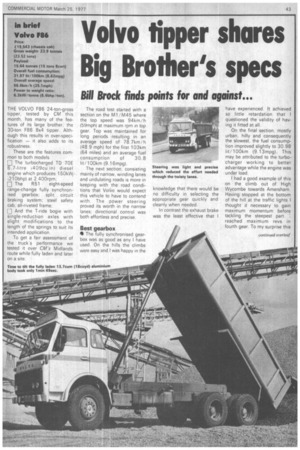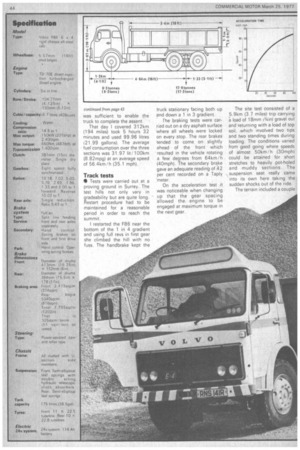Volvo tipper shares Big Brother's specs
Page 45

Page 46

Page 48

If you've noticed an error in this article please click here to report it so we can fix it.
Bill Brock finds points for and against...
THE VOLVO F86 24-ton-gross tipper, tested by CM this month, has many of the features of its large brother, the 30-ton F86 8x4 tipper. Although this results in over-specification -it also adds to its robustness.
These are the features common to both models
[I The turbocharged TD 70E 6 7-litre k409cu in) diesel engine which produces 150kW 1210bhp) at 2.400rpm;
E The R51 eight-speed range-change fully synchronised gearbox; split circuit braking system; steel safety cab, all-riveted frame: (1 And the T-ride bogie with single-reduction axles with slight modifications to the length of the springs to suit its Intended application.
To get a fair assessment of the truck's performance we tested it over CM"s Midlands route while fully laden and later on a site.
The road test started with a section on the M1/ M45 where the top speed was 94km/ h (59mph) at maximum rpm in top gear. Top was maintained for long periods resulting in an average speed of 78.7krn / h (48 9 mph) for the first 103km (64 miles) and an average fuel consumption of 30.8 lit/ 100km (9.16mpg).
The next section, consisting mainly of narrow, winding lanes and undulating roads is more in keeping with the road conditions that VolVo would expect this vehicle to have to contend with The power steering proved its worth in the narrow lanes; directional control was both effortless and precise.
Best gearbox
The fully synchronised gearbox was as good as any I have used. On the hills the climbs were easy and I was happy in the knowledge that there would be no difficulty in selecting the appropriate gear quickly and cleanly when needed.
In contrast the exhaust brake was the least effective that I have experienced. It achieved so little retardation that I questioned the validity of having it fitted at all.
On the final section, mostly urban, hilly and consequently the slowest, the fuel consumption improved slightly to 30.98 lit/100km (9.13mpg). This may be attributed to the turbocharger working to better advantage while the engine was under load.
I had a good example of this on the climb out of High Wycombe towards Amersham. Having stopped at the bottom of the hill at the traffic lights I thought it necessary to gain maximum momentum before tackling the steepest part. reached maximum revs in fourth gear. To my surprise this
was sufficient to enable the truck to complete the assent.
That day I covered 312km (194 miles) took 5 hours 32 minutes and used 99.96 litres (21.99 gallons). The average fuel consumption over the three sections was 31.97 lit/100km (8.82mpg) at an average speed of 56.4km /h (35.1 mph).
th Tests were carried out . at a proving ground in Surrey. The test hills not only vary in gradeability but are quite long. Restart procedure had to be maintained for a reasonable period in order to reach the summit.
I restarted the F86 near the bottom of the 1 in 4 gradient and using full revs in first gear she climbed the hill with no fuss. The handbrake kept the truck stationary facing both up and down a 1 in 3 gradient.
ihe braking tests were carred out on a dry asphalt surface where all wheels were locked on every stop. The rear brakes tended to come on slightly ahead of the front which resulted in the vehicle rotating a few degrees from 64km /h (40mph). The secondary brake gave an adequate reading of .42 per cent recorded on a Taply 'meter.
On the acceleration test it was noticeable when changing up that the gear spacing allowed the engine to be engaged at maximum torque in the next gear.
The site test consisted of a .5.9km (3.7 miles) trip carrying a load of 18mm 3/4 in) gravel out and returning with a load of top soil, which involved two tips and two standing times during loading. The conditions varied from good going where speeds of almost 50km /h (30mph) could be attained for short stretches to heavily pot-holed and muddy sections. The suspension seat really came into its own here taking the sudden shocks out of the ride.
The terrain included a couple shifted 48.87 tonnes (48.11 tons) per hour or 957.8 tonnes (942.8 tons) per mile per hour while consuming 12.4 litres (2.3 gallons) an hour. • The Volvo all-steel tilt cab which was introduced in the early Sixties has been modified to conform to the Swedish crush regulations. Forty degrees of tilt allows sufficient room to carry out a top engine overhaul without removing the engine.
Mounting for the single five-stage Edbro tipping gear is situated to the rear of the cab and is noticeably clear of pipes and bracketing. The Cravens HamaHoy 13.7cum (10cuyd) tipping body is of all-aluminqm construction except for the wearing parts and is mounted on the sturdy rolled steel section chassis frame.
Braking and driving torques are absorbed through the radius rods of the rear bogies to the frames. Volvo claims the bogiesprings can be removed for service in only 45 minutes.
Puncture
e At the end of the site test we suffered the tipper man's hazard -a large flint punctured the inside rear tyre This highlighted the fact that the stud hole spacing on the F86 wheels are neither the same as most British vehicles nor the same as fitted to the F88.
I was told by Mr Ron Cater, Ailsa's market support engineer, the reason why-is that the vehicle, has spiggot-mounted wheels. "If we had the big British pitch circle diameter wheels we would have had to have bigger diameter brake drums, which aren't necessary for a 24-tonner," he said.
Answering my point about the retarder, Mr Cater said: "The engine is of small capacity, so the exhaust brake is .not very effective till you engage a low gear.
"It's used for two purposes: it's an exhaust brake and it's applied at partial pressure to control the exhaust gas temperature in order to eliminate blue smoke when the vehicle 4s starting from cold."
Summary
414 The chassis-cab priced at £.19,543 plus perhaps an extra £2,000 for the body and the tipping gear, will provide the operator with a well made machine built to stand up to the rigours of off-road work with a good performance for short runs and tips. I feel it is a little under-geared for motorway work.
It is expensive -for example a 539 6x4 6LXI3 Gardner engined Foden costs £17,450, But it is built to .do the job and more. With down-time running at about £70 a day its robustness, ease of servicing and availability of spares should also be major considerations.




























































































